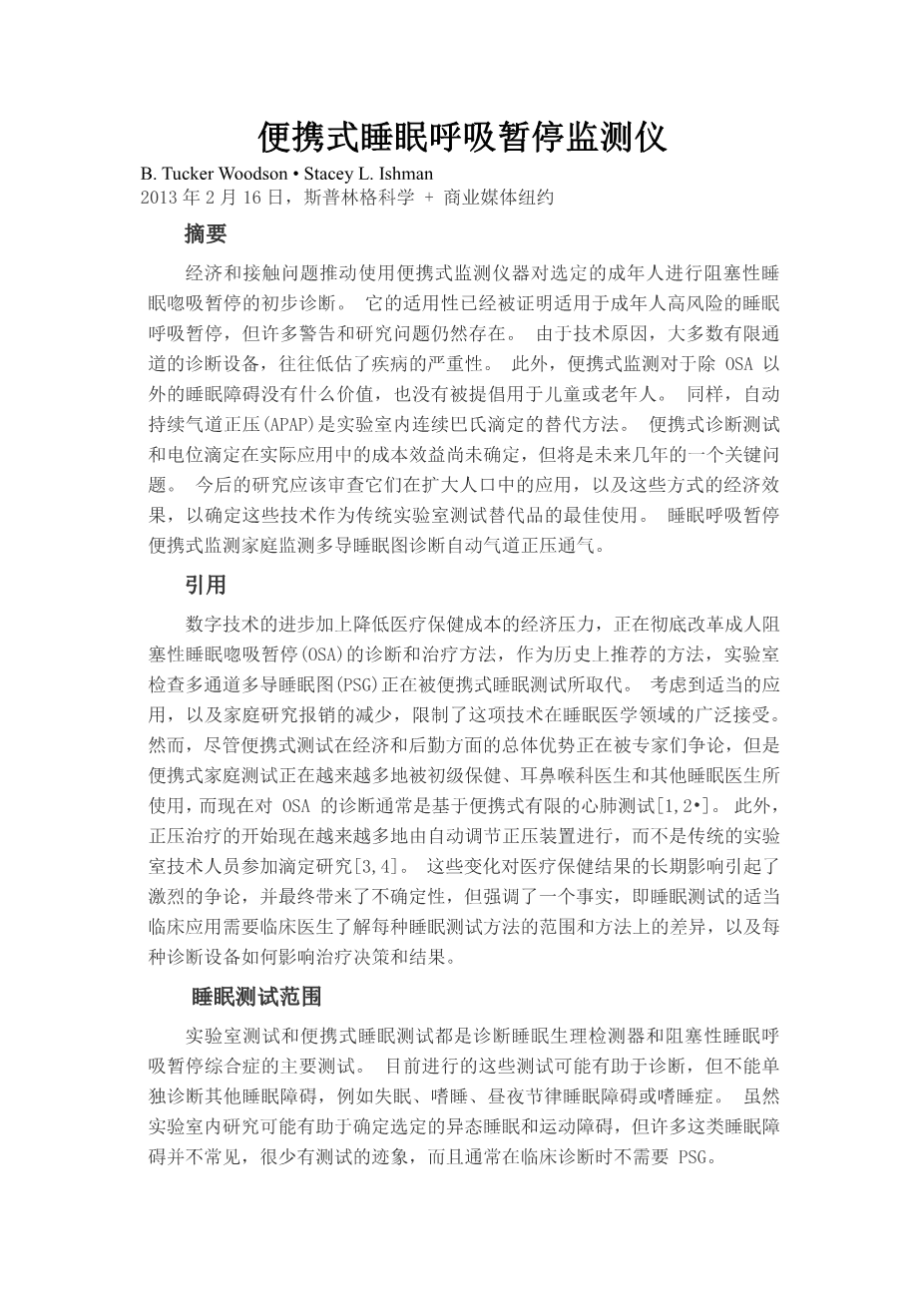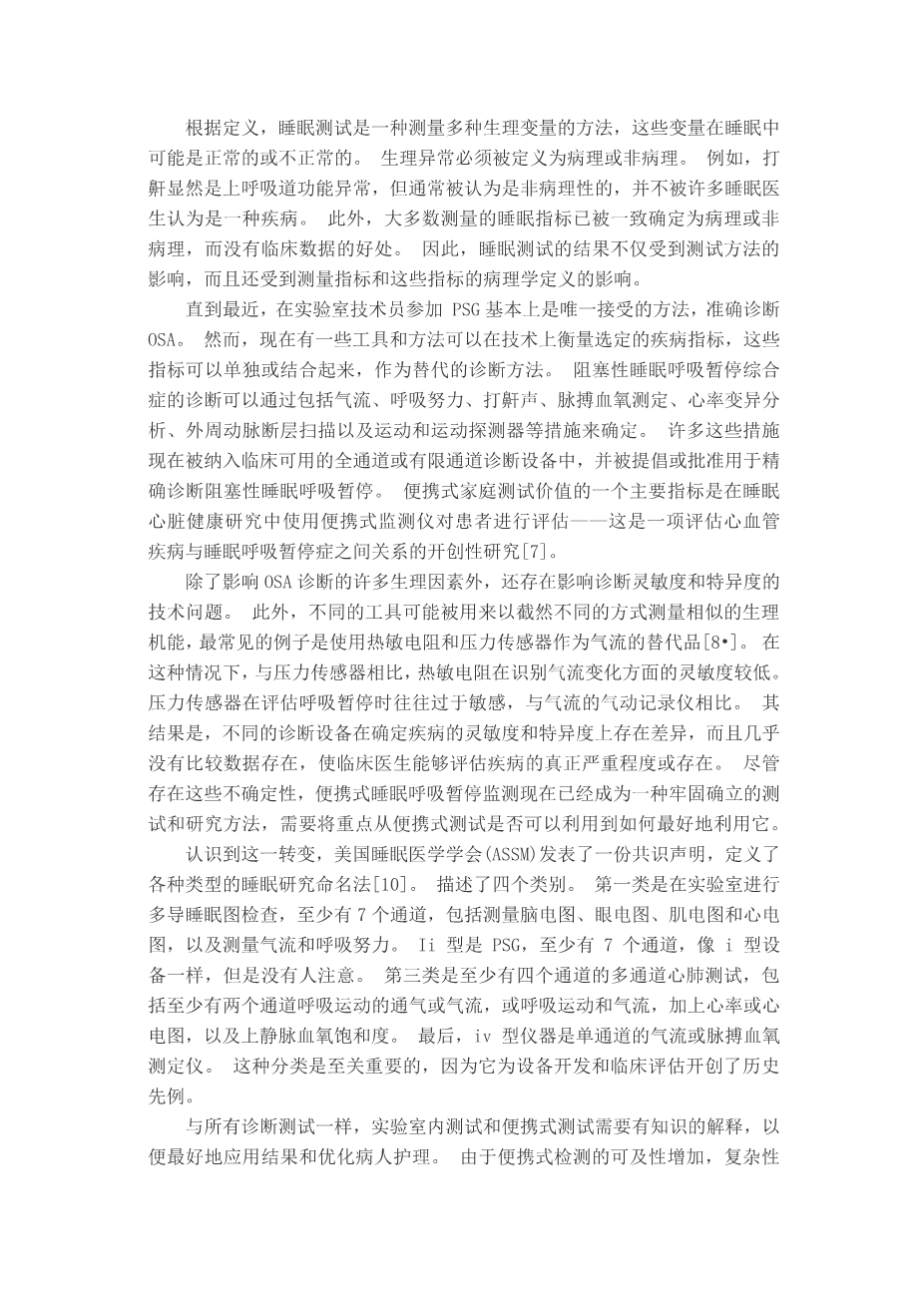Portable Monitoring for Diagnosis of Sleep Apnea
B. Tucker Woodson • Stacey L. Ishman
Published online: 16 February 2013 Springer Science Business Media New York 2013
Abstract
Economic and access issues are driving the use of portable monitoring for primary diagnosis of obstructive sleep apnea (OSA) in selected adults. Its applicability has been demonstrated for adults at high risk of sleep apnea, but many caveats and research questions remain. For technical reasons, most limited-channel diagnostic devices tend to underestimate the severity of the disease. In addition, portable monitoring is of little value for sleep disorders other than OSA and has not been advocated for children or the elderly. Similarly, auto-continuous positive airway pressure (APAP) is an alternative to in-laboratory continuous PAP titration. The cost-effectiveness of portable diagnostic testing and APAP titration in actual practice is yet to be determined, but will be a critical question in the years ahead. Future research should examine their use for extended populations, and the economic effect of these modalities, to determine the best use of these techniques as alternatives to traditional in-laboratory testing. Keywords Sleep apnea Portable monitoring Home monitoring Polysomnography Diagnosis Auto-positive airway pressure APAP Intr.
Troduction
Advances in digital technology combined with economic pressure to reduce the cost of healthcare are revolutionizing diagnostic and treatment for adults with obstructive sleep apnea (OSA) as the historical recommended method, inlaboratory-attended multiple channel polysomnography (PSG), is being replaced by portable sleep testing. Concerns about appropriate application, and the decrease in reimbursement for home studies, have limited broad acceptance of this technology in the field of sleep medicine. However, despite the overall economic and logistical advantages of portable testing being debated by specialists, portable home testing is increasing in use by primary care, otolaryngologists, and other sleep physicians, and diagnosis of OSA is now often determined on the basis of portable limited cardiorespiratory testing [1, 2•]. In addition, initiation of positive pressure therapy is now increasingly being performed by auto-adjusting positive-pressure devices instead of the traditional in-laboratory technician-attended titration study [3, 4]. The long-term effects of these changes on healthcare outcomes are hotly debated and ultimately uncertain, but highlight the fact that appropriate clinical use of sleep testing requires that the clinician understands the scope and methodological differences of each sleep testing method, and how each of these diagnostic devices affects treatment decisions and outcomes.
Scope of Sleep Testing
Both in-laboratory and portable sleep testing are the primary tests used to diagnose sleep disordered breathing and OSA. The tests, as currently performed, may assist in diagnosis, but independently are not diagnostic of othersleep disorders, for example insomnia, hypersomnia, circadian rhythm sleep disorders, or narcolepsy [5]. Although in-laboratory studies may be useful for identifying selected parasomnias and movement disorders, many of these sleep disorders are uncommon, rarely the indication of the test, and are often diagnosed clinically without the need for PSG.
Sleep testing is, by definition, a method of measuring multiple physiologic variables, which may be normal or abnormal, during sleep. Abnormal physiology must then be defined as either pathologic or non-pathologic. For example, snoring is clearly an abnormality of upper airway function but is often regarded as non-pathologic and not believed to represent a disease by many sleep physicians. In addition, most measured sleep metrics have been determined to be pathologic or non-pathologic by consensus without the benefit of clinical data. The results of sleep testing are therefore confounded not only by the method of testing, but also by the metrics measured and the definition of pathology of these metrics.
Until recently, in-laboratory technician-attended PSG was essentially the only accepted method for accurate diagnosis of OSA. However, there are now several tools and methods that can technically measure selected metrics of the disease which separately, or in combination, can serve as alternative methods of diagnosis. OSA diagnosis can be determined using measures that include airflow, ventilatory effort, snoring sounds, pulse oximetry, heart rate variability, peripheral arterial tomography, and motion and movement detectors [6]. Many of these measures are now incorporated into clinically available full or limited channel diagnostic devices, and are advocated or approved for accurate diagnosis of OSA. A major indicator of the value of portable home testing was the use of portable monitors for patient evaluation in the Sleep Heart Health Study—a pioneering study evaluating cardiovascular disease associations and sleep apnea [7].
In addition to the many physiological factors that can affect the diagnosis of OSA, technological issues exist that effect sensitivity and specificity of diagnosis. In addition, different tools may be used to measure similar physiology in vastly different ways; the most common example of this is the use of thermistors versus pressure sensors as surrogates for airflow [8•]. In this case thermistors have lower sensitivity in identifying changes in airflow compared with pressure sensors. Pressure sensors are often overly sensitive in assessing apnea when compared with pneumotachograph measurements of airflow. The result is that different diagnostic devices vary in sensitivity and specificity in identifying disease and virtually no comparative data exist to enable the clinician to assess the true severity or presence of disea
剩余内容已隐藏,支付完成后下载完整资料


英语译文共 6 页,剩余内容已隐藏,支付完成后下载完整资料
资料编号:[425241],资料为PDF文档或Word文档,PDF文档可免费转换为Word
以上是毕业论文外文翻译,课题毕业论文、任务书、文献综述、开题报告、程序设计、图纸设计等资料可联系客服协助查找。


